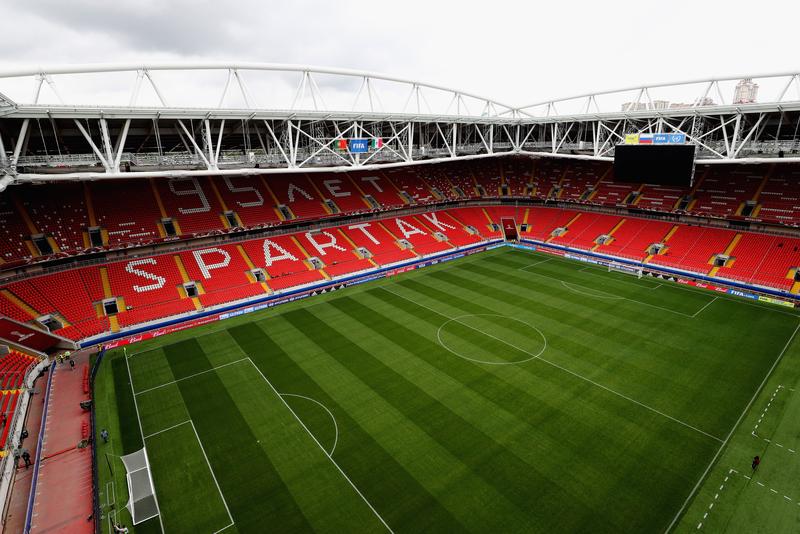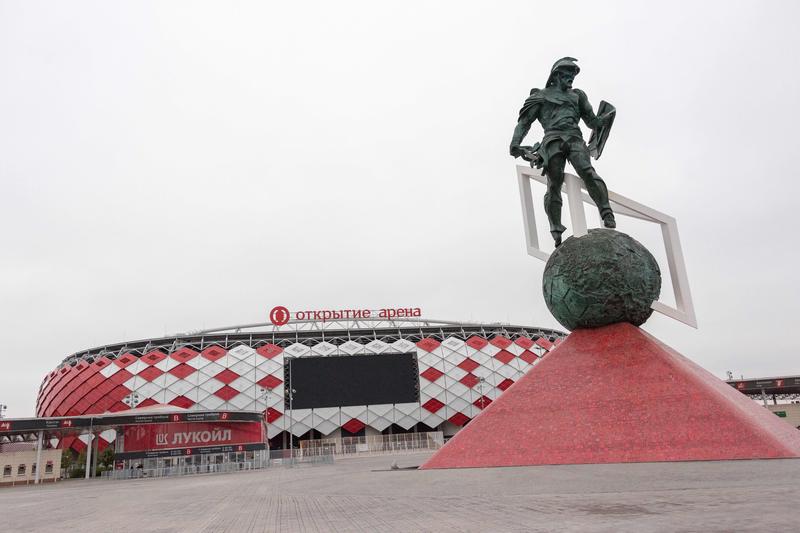The new stadium of Spartak Moscow is the perfect aesthetic representation of the history of the club.
On the Otkritie Arena were played the games:
Argentina-Iceland (Group D), 16 June 2018
Poland-Senegal (Group H), 19 June 2018
Belgium-Tunisia (Group G), 23 June 2018
Serbia-Brazil (Group E), 27 June 2018
And it will also be host to:
Best of 16 1H-2G, July 3, 2018
The Otkritie Arena, the stadium of the Spartak Moscow opened in 2014, is the first "home" facility that the Russian club can define as such, in its history. The "People's Team", as the team is nicknamed, has never had its own stadium in almost a century of life, playing, indeed, the home games on various facilities and playgrounds around Moscow.
If we think of Moscow and Spartak, it is above all the Luzhniki Stadium that comes to mind. The national stadium recalls the 90s, which saw the club of the capital as the flagship of the newly formed Russia in the European cups. Ronaldo's goal with the Inter jersey in Moscow mud, in the semifinals of the 1997/98 UEFA Cup, is one of the most evocative memories of a team that also reached the quarter-finals of the 1996 Champions League (beaten by Nantes who, in turn, will lose in the semifinals with Juventus, ready to win the trophy in Rome that year).
Luzhniki has also put the history of Spartak in touch with that of Torpedo Moscow, another club in the Russian capital that in that decade was acquired by the company that owns the stadium, finding itself at home in the plant, unlike Spartak who continued to play a bit here and a bit in the stadium of Lokomotiv. Three years ago, finally, the itinerant history of Spartak, fascinating but perhaps not very suited to a team with the historical identity of the "Krasno-Belye" (red-white, Russian), ended with the inauguration of the Otkritie Arena.
The long project
The idea of a new stadium for Spartak Moscow had made its way for the first time at the beginning of the new millennium, when the new owner, Andrei Chervichenko, bought the club by putting at the front Oleg Romantsev - the historic coach responsible for the successes of the 90s, with nine championships won between 1992 and 2001, and owner of a substantial share of the club.
Although Chervichenko was the winner of the internal feud against Romantsev, in 1998 he found himself involved in the investigation into the illegal transfer of money for Alenichev's passage to Rome (facts to which Chervichenko was probably not a member, but which nevertheless fell under his management five years late). Chervichenko, a billionaire with major investments in the oil sector, decided to give its shares to Leonid Fedun (one of the main shareholders of the Russian energy conglomerate Lukoil) in 2004, with whom the steps to the new stadium finally become concrete.

In 2006, the federal government gave the club nearly 30 acres of land on the site of the former military airfield in Tushino, north of Moscow. In 1991 the Metallica had performed here, in a concert that remains historic, while CSKA Moscow won the last Soviet championship before the dissolution of the USSR (with two points of advantage over Spartak).
The ceremony of laying the foundation stone took place in 2007, with the inauguration (optimistically) planned for 2010. In 2009, in fact, of constructed there is only that foundation stone, and the stadium is still stationary on the project sheets. The problem is a style described as 'too ordinary' by the selection board, which rejects it and refers it to a new revision.
Financed by the owner Leonid Fedun, through Lukoil (Spartak's main sponsor since 2000), the stadium finally starts its construction process in October 2010 and sees the light four years later, with the opening match of September 5, 2014, Spartak-Belgrade Red Star 1-1.
Forged by history
Set in the natural context of a small forest, marked by the Khimka Reka channel (affluent of the Moscow River), the Otkritie Arena can accommodate 46,000 spectators and is a stadium that makes of symbology its distinctive feature.
Stylistically similar to the Allianz Arena in Munich, with its rounded rectangular plan, it was designed by the Russian section of AECOM (already present in several sports projects, not least the Mercedes-Benz Stadium in Atlanta), in synergy with London-based Dexter Moren Associates (involved in the design of some facilities of St George's Park, the sports center of the English Football Association).
Inside, it has two levels of rather classic staircases, which embrace the field with the bright red of the seats, obviously to pay tribute to the social color of Spartak. The roof is slightly suspended from the last row of the stands and the white of the reticular structure on the four inner sides contrasts with the compactness of the steps below. The structure of the roof has also been designed to best combine a low own weight with an excellent load capacity: the wide temperature range and frequent snowfalls, typical of the Moscow climate, have influenced the construction of the drainage channels and an optimal distribution of the loads expected on the roof.
But it is outside that the real symbolic side of the system is outlined. The west side of the stadium is marked by full-height windows, while the other three sides of the stadium are seamlessly wrapped by a weave of structural glass panels overlapped by a rhombus shape, alternating a shade of red to white and vice versa. Everything is defined by the shape of the emblem of Spartak Moscow (designed in 1935), which is declined in this coating and completely characterizes the identity of the club house. Part armory-effect, part modern texture, enveloping the stadium and combining history with the club's contemporaneity. A very rare case in which almost all the external structure of a stadium is characterized by an aesthetic referring to the team that it hosts.

To make the stadium even more celebratory of the club's history, there are also commemorative statues inside and outside the stadium. On the edge of the field is the wonderful sculpture of the four Starostin brothers, founders of Spartak, seated on a bench to follow ideally every game of their club. Outside, in front of the entrance to the north flight of steps, there is a huge statue of the gladiator Spartacus, to whom the team owes its name and philosophy of fighting to change its destiny. The monument rises on a large red pyramid and welcomes fans at a height of 25 metres: the gladiator rests his feet on a large sphere that mixes a soccer ball with metal fragments reminiscent of Russia's industrial past, and is set against it by means of a stylized three-dimensional rhombus that traces a sign of modernity and identity at the same time.
Comments